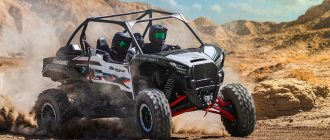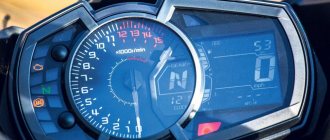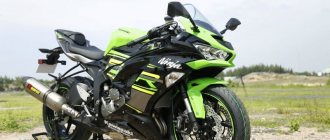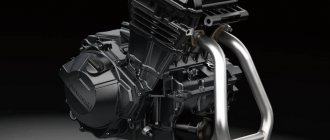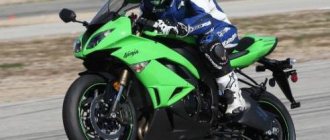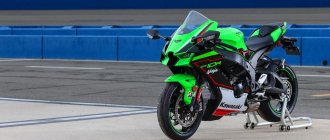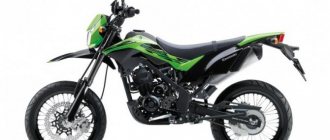| Kawasaki GPZ900R (Ninja 900) 1984-1990 | Kawasaki GPZ900R (Ninja 900) 1991-1998 | Kawasaki GPZ900R 1999-2003 |
Kawasaki GPZ900R sports motorcycle
was first introduced in 1984 and was Kawasaki's earliest sports model.
In those years, the motorcycle was distinguished by its innovative appearance, but the most notable thing was its engine - an inline 4-cylinder liquid-cooled unit with a volume of 908 cc. see, produced a fantastic 115 hp for those times, accelerating the motorcycle to 243 km/h, which was a record among mass-produced road motorcycles. On the North American market, this motorcycle is called Kawasaki Ninja 900
.
The Kawasaki GPZ900R also led to a significant breakthrough for Japanese motorcycles in the Superbike class. Despite the standard technical features of those years - a steel frame, 16- and 18-inch wheels, air suspension, etc. - the motorcycle not only had outstanding dynamic characteristics, but also handled excellently. The reason for this was the special location of the engine, which “sat” slightly lower in the frame, thereby reducing the center of gravity.
In 1984, based on the GPZ900, a 750 cc modification was built - the Kawasaki GPZ750R.
In 1986, Kawasaki released a new model, the GPZ1000RX, which was supposed to be a replacement for the GPZ900R, but both motorcycles continued to be produced in parallel. And even the release of the Kawasaki ZZ-R1100 (in 1990) did not radically change the situation - the Kawasaki GPZ 900 continued to be produced and sold in Europe until 1993 inclusive. In 1998, motorcycle production was moved to Malaysia, from where the model went to the domestic Japanese market (and some Asian countries). It was not until 2003 that production of the Kawasaki GPZ900R was finally stopped.
The Kawasaki GPZ900R model had the following names:
- Kawasaki Ninja 900
- Kawasaki ZX900A
The main competitors of the Kawasaki GPZ900R in the class:
- Yamaha XJ 900 S Diversion
Brief history of the model
- 1984 - start of mass production and sales of the Kawasaki GPZ900R model.
Model
: Kawasaki Ninja 900 (North America).
Frame
: ZX900A-000001~, ZX900A-015004~, JKAZX2A1-EA000001~.
Factory designation
: ZX900-A1
- 1985 - no significant changes.
Model
: Kawasaki Ninja 900 (North America).
Frame
: ZX900A-015001~015003, ZX900A-015501~, JKAZX2A1-FA015001.
Factory designation
: ZX900-A2
- 1986 - the model begins to be sold in Europe under the name Kawasaki GPZ900R.
Model
: Kawasaki Ninja 900 (North America), Kawasaki GPZ900R (Europe).
Frame
: ZX900A-031001~035100, JKAZX2A1=GA031001~.
Factory designation
: ZX900-A3
- 1987 - Model available only in Europe.
Model
: Kawasaki GPZ900R.
Frame
: ZX900A-035101~.
Factory designation
: ZX900-A4
- 1988 - The model receives brake discs from the GPZ1000RX.
Model
: Kawasaki GPZ900R.
Frame
: ZX900A-038501~.
Factory designation
: ZX900-A5
- 1989 - the model receives heated carburetors.
Model
: Kawasaki GPZ900R.
Frame
: ZX900A-042001~, JKAZX2A1=KA042001~.
Factory designation
: ZX900-A6
- 1990 - the maximum power of the motorcycle is reduced to 108 hp, the dry weight increases to 234 kg, the voltmeter disappears from the dashboard, the design of the mirrors and seat changes. The motorcycle receives new wheels with increased dimensions and a new braking system. The front fork increases the diameter of the stays from 38 to 41 mm and receives an anti-dive system. The mufflers become 3 cm longer.
Model
: Kawasaki GPZ900R.
Frame
: ZX900A-048001~, JKAZX2A1=LA048001~.
Factory designation
: ZX900-A7
- 1991 - in addition to the European market, the model becomes available in Japan - a version identical to the A7, but with reduced power (89 hp), torque (72 Nm) and top speed (limited to 180 km/h).
Model
: Kawasaki GPZ900R.
Frame
: ZX900A-056001~, JKAZX2A1=MA056001~ (Europe);
ZX900A-058183~ZX900A-059848 (Japan). Factory designation
: ZX900-A8
- 1992 - Model available only in Japan. The previous generation (A8) is being exported.
Model
: Kawasaki GPZ900R.
Frame
: ZX900A-063001~ZX900A-063892.
Factory designation
: ZX900-A9
- 1993 - last year of production in Europe (A8 generation sold).
Model
: Kawasaki GPZ900R.
Frame
: ZX900A-068001~078000~ (Europe);
ZX900A-068921~070887 (Japan). Factory designation
: ZX900-A10
- 1994-1997 - the model is not produced.
- 1998 - production moves to Malaysia, the main market is Japan.
Model
: Kawasaki GPZ900R.
Frame
: ZX900A-078001!ZX900A-080555.
Factory designation
: ZX900-A11.
- 1999 - The model receives new 6-piston front calipers and radial tires.
Model
: Kawasaki GPZ900R.
Frame
: ZX900A-085001~ZX900A-087079.
Factory designation
: ZX900-A12.
- 2000 - no significant changes.
Model
: Kawasaki GPZ900R.
Frame
: ZX900A-090001~ZX900A-090474.
Factory designation
: ZX900-A13.
- 2001 - no significant changes.
Model
: Kawasaki GPZ900R.
Frame
: ZX900A-092001~ZX900A-092690.
Factory designation
: ZX900-A14.
- 2002 - To meet new environmental emissions standards, the model receives a KCA (Kawasaki Clean Air) catalyst.
Model
: Kawasaki GPZ900R.
Frame
: ZX900A-095001~.
Factory designation
: ZX900-A15.
- 2003 is the last year of production. This year's models feature the Final Edition badge.
Model
: Kawasaki GPZ900R.
Frame
: ZX900A-097001~ZX900A-097162.
Factory designation
: ZX900-A16.
From the history of the Kawasaki GPZ 900 R superbike
In 1984, almost immediately after the model's release, a Kawasaki dealer brought three slightly modified stock Ninja GPZ 900 R to the famous Maine TT race, where these bikes won the first two places in the overall standings .
This contributed to an incredible increase in sales of the model throughout the world, as it caused an unprecedented resonance among the advanced motorcycle community.
Over the thirty years of its existence, the Kawasaki GPZ 900 R has undergone many changes in design and construction.
Thus, the front wheel has noticeably increased in size compared to the starting version, the front fork has become significantly stronger, thanks to an increase in the diameter of the guide pipes, and four-piston calipers have appeared on the disc brake system.
However, the motorcycle has retained its charisma and attractiveness .
Specifications
Technical characteristics of Kawasaki GPZ900R:
| Model | Kawasaki GPZ900R (Ninja 900, ZX900A) |
| Motorcycle type | sports tourist |
| Year of issue | 1984-2003 |
| Frame | steel |
| engine's type | 4-cylinder, 4-stroke, in-line |
| Working volume | 908 cm³ |
| Bore/Stroke | 72.5 x 55.0 mm |
| Compression ratio | 11.0:1 |
| Cooling | liquid |
| Number of valves per cylinder | DOHC, 4 valves per cylinder |
| Fuel supply system | carburetor, 4x Keihin CVK34 |
| Ignition type | transistor |
| Maximum power | 115.0 hp (84.6 kW) at 9500 rpm – Max. ZX900-A1~A6 108 hp (79.4 kW) – Max. ZX900-A7+ 110.0 hp (80.9 kW) at 9500 rpm – ZX900-A3~A6 (USA) 100.0 hp (73.5 kW) – ZX900 (Germany, France) 86 hp (63.2 kW) at 9000 rpm – ZX900A8-A16 (Japan) |
| Maximum torque | 85.3 Nm (8.7 kgf*m) at 5000 rpm – Max. 72 Nm (7.3 kgf*m) at 6500 rpm – ZX900A8-A16 (Japan) |
| Clutch | Multi-disc in oil bath, hydraulic drive |
| Transmission | 6-speed |
| type of drive | chain |
| Front tire size | 120/80-16 – ZX900-A1~A6 120/70-17 – ZX900-A7~A16 |
| Rear tire size | 130/80-18 – ZX900-A1~A6 150/70-18 – ZX900-A7~A16 |
| Front brakes | 2 discs, 280 mm, 1-piston calipers – ZX900-A1~A6 2 discs, 300 mm, 4-piston calipers – ZX900-A7~A11 2 discs, 300 mm, 6-piston calipers – ZX900-A12~A16 |
| Rear brakes | 1 disc, 270 mm, 1-piston caliper – ZX900-A1~A6 1 disc, 250 mm, 2-piston caliper – ZX900-A7~A16 |
| Front suspension | 38mm telescopic fork, 140mm travel – ZX900-A1~A6 41mm telescopic fork (anti-dive), 140mm travel – ZX900-A7~A16 |
| Rear suspension | pendulum with monoshock absorber, stroke - 115 mm |
| Dimensions (L x W x H) | 2200 x 750 x 1215 mm |
| Wheelbase | 1495 mm |
| Seat height | 780 mm |
| Minimum ground clearance (clearance) | 140 mm |
| Acceleration 0-100 km/h (0-60 mph) | 3.6 sec[1] |
| Maximum speed | 241 km/h[2] 180 km/h - Japanese versions (since 1991) |
| Gas tank capacity | 22.0 l (including reserve - 4.0 l) |
| Motorcycle weight (dry) | 228 kg – ZX900-A1~A6 234 kg – ZX900-A7~A16 |
| Motorcycle weight (curb) | 249 kg – ZX900-A1~A6 255 kg – ZX900-A7~A16 |
Reviews
Reviews about Kawasaki GPZ900R:
Expand Collapse
At the end of 1983, a version appeared with an increase to 908 cc. engine capacity - GPz900R. The chassis has not changed, only the engine has changed. In all likelihood, the idea of the Japanese engineers was to build a “liter,” but American regulations forced them to first produce a 750 cc version, “especially for the track.” Therefore, the increased volume and 115 hp. did not require intervention in the suspension and frame of the motorcycle. The bike immediately became a bestseller all over the world straight from the factory. More than 70,000 nine hundred units have been sold since then. In Japan, the 86-94 models are still considered iconic. The motorcycle was delivered to Europe slightly trimmed to 100 hp. version (in accordance with the requirements of the laws of Germany, France, and a number of other countries where the power of large-capacity heavy bikes was limited).
The GPz 900 had the first fully balanced in-line engine with liquid cooling and 4 valves per cylinder DOHC16. An aluminum swingarm with a UNI-TRAK monoshock absorber, which has two (and in the racing version SBK three) settings, provided excellent grip both on the track and on the road. But the main feature of the 900 cc “toad” was the speed record: even in the factory configuration, the motorcycle reached a speed of 240 km/h (a small tuning squeezed all 270 out of the engine). From January 1984 to 1992, the “Bike of the Year” titles were earned by the GPz900R (and even the 750R a couple of times) by completely honest work. There are 8 of them in total - in Europe (three times), the USA (twice), Japan and other countries (sorry, I couldn’t find information about which ones except Japan).
I got this equipment from 1988. 900cc, 100 lashes, weight about 250 kg. Tell me, a lot of weight, not enough horses? The Japanese are smart people, they have made high-quality sports tourism. Although old, the model was produced until 1994... Low center of gravity, lack of sharp dips and pick-ups, steam-powered traction from the bottom, comfortable fit, good wind protection, anti-click system, decent brakes. The pros can be listed endlessly... This motorcycle has one minus, age... It's a shame they don't produce such equipment anymore...
Photo gallery
The beautiful design and powerful characteristics of the model led to its popularity. Despite the fact that there are now many new, more modern models, it is not losing demand. In this collection you can trace the evolution of the Kawasaki GPZ 900 R motorcycle and evaluate its external characteristics.

